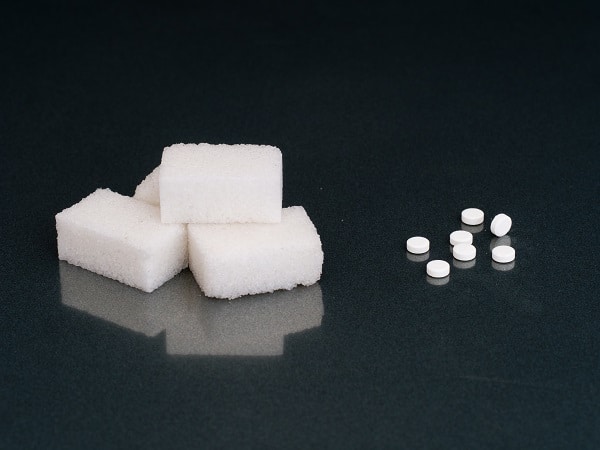You’re a health-conscious shopper. When choosing healthy snacks for the kids, you’ll pick up that yogurt container and take a look at the nutrition label. Low in calories and added sugar? Check. And so that yogurt finds a home in your shopping cart.
But you may have overlooked something.
We all understand that most “diet” foods and drinks that have no calories are artificially sweetened, as are many junk foods. But artificial sweeteners are often present in regular foods, like bread, canned foods, jam, and yogurt. In an effort to provide the products that consumers want — foods low in added sugar but still as sweet as ever — manufacturers leave out added sugar and sweeten their products artificially.
How does a savvy shopper make a decision?
On the one hand, over-consumption of sugar is an epidemic in this country. The average child consumes more than THREE TIMES the recommended amount of added sugar every day. Both adults and children consume more than 50 pounds of pure sugar annually. We crave sweetness, and sugar is prolific in our highly-processed foods, making it easy to consume far too much of it. After all, a single 12 oz can of soda contains nearly double the daily recommended levels of sugar. Sugar substitutes offer value because they are many times sweeter than sugar and have low or no calories. If artificial sweeteners help to cut back on sugar, aren’t they worth it?
On the other hand, artificial sweeteners bring with them a host of questions about their safety. Suspicions that they may be responsible for cancer, multiple sclerosis, and many other health problems have been abundant for decades. To pile on, artificial sweeteners might even be addictive!
What Does the Evidence Say About Artificial Sweeteners
We can only make decisions with the knowledge that we possess. While science is sometimes an imperfect process, it is the best method of discovery that we have. The debate on artificial sweeteners exceeds 50 years, and due to public interest has become one of the most researched areas in health. We don’t have the space to cover everything here, but we can simplify what thousands of studies and hundreds of institutional and regulatory bodies all say:
Most of the big issues that have scared people away from artificial sweeteners don’t hold up to scrutiny. In fact, most of those rumors about horrid side-effects can attribute their origin to a very popular hoax.
Worries about cancer go back to studies in the 1970s when rats megadosed with saccharin developed bladder cancer. Many followup studies showed that it was a side effect unique to rat biology and is not applicable to humans. Similarly, health issues that early on were thought to be attributed to sugar substitutes were actually due to problems in the studied populations.
For example, a person at high risk for diabetes, obesity, and heart disease might be prone to using a sugar substitute as damage mitigation. If they aren’t successful, it’s due to genetics and lifestyle, not their Diet Coke.
After rigorous study, the American Heart Association (AHA) and the American Diabetes Association (ADA) have given a nod to the use of artificial sweeteners in place of sugar to combat obesity, diabetes, and heart disease.
The FDA has approved five artificial sweeteners: saccharin, acesulfame, aspartame, neotame, and sucralose. It has also approved one natural low-calorie sweetener, Stevia. They’ve also provided conservative recommendations for an Acceptable Daily Intake (ADI), an amount deemed safe for daily consumption. Each of these sugar substitutes acts differently in the human body, so what is true with one isn’t necessarily true of another.
Why We Should Still Be Cautious With Artificial Sweeteners
There might not be evidence that these approved sugar substitutes have dire health consequences, but they still may not be as beneficial as one might hope.
Animal studies suggest that artificial sweeteners may be addictive. In studies of rats who were exposed to cocaine, then given a choice between intravenous cocaine or oral saccharine, most chose saccharin.
It’s also possible that artificial sweeteners change the way we taste food. They are all far more potent than natural sugars or table sugar. This may prevent us from associating sweetness with caloric intake, especially in children.
Overstimulation of receptors from hyper-intense sweeteners could mean that naturally sweet foods, such as fruit, are less appealing and unsweet foods, such as vegetables, are downright unpalatable. As a result, we may crave more sweets, tend to choose sweet food over nutritious food, and gain weight.
Sugar Substitutes — How Much is TOO Much?
Saccharin
Sold under the brand names Sweet’N Low, Sweet Twin, NectaSweet, and others, saccharin has been around the block. This is the same substance responsible for the bladder cancer issue in rats mentioned above, which resulted in warning labels and temporary removal from markets. It has subsequently been labeled as safe.
ADI is 15 mg/kg, a range of 300-1,200 mg per day. One packet of Sweet‘n Low contains 36 milligrams of saccharin.
Acesulfame Potassium
Acesulfame Potassium is very popular in beverages. Due to a slightly bitter aftertaste, it’s often combined with other sweeteners. It has a long shelf-life and is stable under heat, and so is used in baked goods, medications, and protein shakes.
ADI is 15 mg/kg, a range of 300-1,200 mg per day. One 12 oz. Coke Zero contains 46 milligrams of acesulfame potassium.
Aspartame
Aspartame is one of the most-studied food ingredients of all time. Despite approval from regulatory agencies around the world, many are still skeptical of this sugar substitute. Aspartame contains the essential amino acid phenylalanine, so those with the rare disease phenylketonuria must avoid this additive (warning labels will be present on products containing aspartame, much like you’d see warnings for peanut allergies).
ADI 50 mg/kg, a range of 1,000-4,000 mg per day. One can of Diet Coke contains 188 milligrams of aspartame.
Neotame
Neotame is the successor to aspartame, and is in fact a derivative of it. It is free of phenylalanine, so it is safe for those with phenylketonuria. It’s also the most potent sweetener known, being thousands of times sweeter than sucrose and 30-50 times sweeter than aspartame.
ADI .3 mg/kg, or 6-24 mg per day. One soda sweetened with neotame contains about .006 milligrams of this sugar substitute.
Sucralose
Popularly known under the brand “Splenda”, sucralose has had a lot of commercial success due to favorable comparisons against its peers in taste, stability, and safety. It’s unique in that it’s available in a granulated form that allows a volume-for-volume substitution for sugar (although it doesn’t taste exactly the same as sugar).
ADI 5 mg/kg, or 100-400 mg per day. One Diet Mountain Dew contains 27 milligrams of sucralose.
The Final Word
When choosing sugar substitutes, it pays to be a savvy consumer. Artificial sweeteners and sugar substitutes may help with weight management and diabetes (ask your doctor) — and they won’t cause cavities. But they aren’t a magic bullet and should be used only in moderation by adults. The occasional or incidental consumption of sugar substitutes in a low sugar dessert isn’t something that should worry you, just don’t develop a habit of drinking Diet Coke all day.
In children, we recommend avoiding artificial sweeteners as much as is practical. While they are regarded as safe, there is still a fair amount of gray area and no benefit for children.
Hooking developing children on extreme sweetness is a disservice that could impede them for life. An occasional naturally-sweetened soda isn’t the end of the world, and preferable to drinking artificially sweetened drinks every day. Better yet, drink water!


Comments are closed.